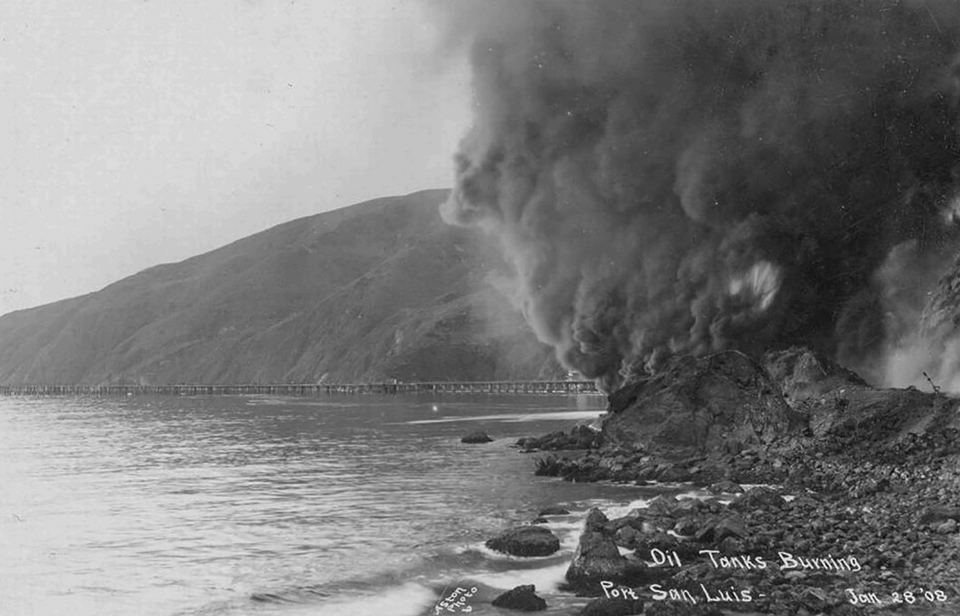The stories–both published and told around the small town—could easily claim the unparalleled event was “History in the Making.” It is doubtful anyone then would even guess that the saga of the Tank Farm Fire would last nearly a century.
Today, in a notable moment of time, the disastrous event is almost “history at the end.” The local disaster has faded from memory since that extraordinary morning when the ground shook, black clouds covered the morning light, and lives were lost. The catastrophic community calamity is finally being allowed to also physically slip into the recesses of local lore.
Anyone who has used the increasingly dangerous stretch of road of the same name in San Luis Obispo will be relieved as safety and commercial development become the primary concern rather than who pays for what. The two-lane street is a major east-west link in a community’s eclectic roadways with few crosstown connections. Motorists, bicycle riders—and a few brave or clueless pedestrians—don’t need their attention distracted by thoughts of the historic nature of the roadway. Yet, no other county road has provided as dramatic—and deadly—a setting for travelers.
Here’s the story: Any concern about the weather that morning was heightened by the consistent rain that was destined to dump five inches within 48 hours. Nonetheless, the day would remain an indelible memory for anyone residing in the community of about 8000 and not simply because of the weather. Surely an event to cause extreme anguish to today’s environmentalist, on April 7, 1926, millions of gallons of flowing and ignited oil resulted in a conflagration of unthinkable proportions. Newspaper accounts relate the event in doomsday proportions as explosions rocked the ground and flames—reported as 1000 feet—catapulted into the heavens and smoke choked any vision of light.
At 7:45 a.m., lightning struck two or three oil reservoirs (tanks) simultaneously. Eyewitnesses saw the bright tongues flash from above into the ground. Enormous explosions sent the wooden tops into the sky. No one slept as the end of the world just might be happening in the central coast valley. In the days before sonic booms, the loud beginning of a five-day fire tallied millions of gallons of oil lost along with crops, structures and two lives. Fortunately, even greater loss was averted as the tank farm was located on the then outskirts of the city.
A large portion of the American economy sailed across oceans of the black gold. Progress was literally fueled from ancient deposits still extracted from the earth. Wells in Kern and Taft County were connected to pipelines transporting the valuable commodity to tankers waiting at Avila’s shores to transport the liquid bonanza elsewhere. Along the way, storage facilities—tank farms—were needed.
The one here was considered the largest in the country. In a construction project worthy of its own story, the reservoirs were as vast as the influence of the oil companies. Built in 1910, the massive underground reservoirs measuring 600 feet in diameter at a depth of twenty feet were fed from an eight-inch pipe at 900 barrels an hour. It would take six weeks of non-stop pumping to fill the cavernous repositories. Prosperity was visible as millions of barrels to fuel the future occupied the farm covering hundreds of acres in the rural community… until that Wednesday morning. A random bolt of lightning unleashed in seconds underscored nature’s power and energy leaving a legacy of a century of pollution now witnessing final remediation.
Thinking the worst may be over, another explosion on Friday added to the dismal vision of what might be considered the reception hall of hell. The blaze was so intense, it depleted oxygen to the point that untold number of windows broke, six structures collapsed, trees were uprooted and roofs destroyed and losses beyond calculation.
Over five days, the inferno reigned supreme. There was no way to contain the blaze. Enormous plumes of earth-bound clouds darkened the skies and were seen as far away as Fresno. Sheep in Santa Margarita became black overnight and the rain swollen San Luis Creek, a “ribbon of light,” became a serpentine dragon of fire burning trees and brush along its way to the coast where untold gallons of goo washed ashore onto local beaches.
Fortunately, the terrain sloped south so as to avoid the city to the north. Under a “field of oil,” acres of earth—flatlands of fire— took years to recover. Depending on various reports, the loss was $10,000,000 as the legacy of waste consumed itself. Lost revenue, pollution, anguish and fear were instant as the unthinkable explosions created a dismal chapter in local history. As awful as the event was, its culmination was the loss of lives. Interviewed some 60 years later,
Doris Seeber recalled the day the explosions took everything from her but her life. Living with her widowed father and grandfather on their ranch near today’s Santa Fe Road, the decision was finally made to leave. As vivid over a half-century later as that day, she grabbed what little she could carry and ran toward the family car. Then, “twirling fire-generated winds,” she remembered, tossed her and the car 15 feet into the air and into the creek. Looking back into desolation, only the foundation remained of her home. Her father and grandfather had been inside. So intense was the wind, family photos were found as far away as Pozo. Attempting to salvage as much oil as possible, Union Oil tankers docked in Avila. One, the SS Montebello, has its own niche in local history summarized next month in these pages.
While a most eventful calamity locally, the Tank Farm fire was not unique. Within days, lesser fires were reported from Brea in southern California and eastward in Bakersfield. Closer to home, on January 27, 1908, the tank farm fire in Avila provided a preview of the local catastrophe.
There, storage tanks ignited in mid-afternoon. Heard ten miles away in the county seat, the earth shook as the clouds of burning oil coiled upward into the sky from the tanks built in 1906. The Avila Fire was neither as spectacular nor as deadly as the one 16 years later but was caused by the same source—lightning. Obviously, not learning from history, there were no lightning rods placed near the San Luis tanks. In the end, Union Oil continued its operations on a lesser scale. Over the years, the remaining tanks were removed and, at least for a century, open space was kept away from increasingly ravenous developers. At one time, a suggestion was made to develop a golf course.
Hopefully, that dream is alive and some of the acreage will be left as open space and, possibly, with a marker to remember the tragic event when nature reminded everyone that progress has a price tag.





